

EF6: Writing Your Own Code First Migration Operations. Posted on February 27, 2013.
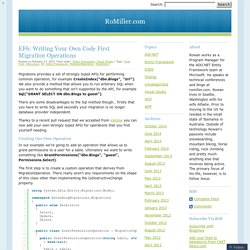
Filed under: Entity Framework, Visual Studio | Tags: Code First, DbContext, EF, Entity Framework, MigrationOperation, Migrations | Migrations provides a set of strongly typed APIs for performing common operation, for example CreateIndex(“dbo.Blogs”, “Url”). We also provide a method that allows you to run arbitrary SQL when you want to do something that isn’t supported by the API, for example Sql(“GRANT SELECT ON dbo.Blogs to guest”). There are some disadvantages to the Sql method though… firstly that you have to write SQL and secondly your migration is no longer database provider independent. Thanks to a recent pull request that we accepted from iceclow you can now add your own strongly typed APIs for operations that you find yourself needing.
Creating Our Own Operation. Untitled. EF Migrations Tips. Migrations are very powerful.
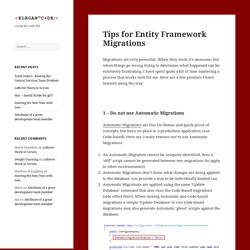
When they work it’s awesome, but when things go wrong trying to determine what happened can be extremely frustrating. I have spent quite a bit of time mastering a process that works well for me. Here are a few pointers I have learned along the way: 1 – Do not use Automatic Migrations Automatic Migrations are fun for demos and quick proof of concepts, but have no place in a production application (use Code-based). An Automatic Migration cannot be uniquely identified, thus a ‘diff’ script cannot be generated between two migrations (to apply to other environments). 2 – Know the _MigrationHistory Table The _MigrationHistory Table provides metadata about the database. 3 – Migrations are both ‘Up’ and ‘Down’ Each migration has the concept of ‘Up’ and ‘Down’, where ‘Up’ applies the changes to the target database and ‘Down’ reverts them. 4 – If you ‘re-scaffold’, make sure to undo first (Down) ‘Re-scaffolding’ regenerates an existing migration with additional changes.
EF Migrations Tips. EF Migrations Tips. SketchPad. Sample Entity Framework Provider for Oracle. This is a Sample Entity Framework Provider for Oracle.
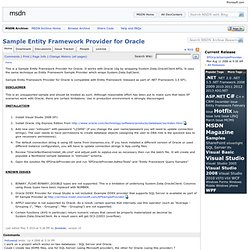
It works with Oracle 10g by wrapping System.Data.OracleClient APIs. It uses the same technique as Entity Framework Sample Provider which wraps System.Data.SqlClient. Sample Entity Framework Provider for Oracle is compatible with Entity Framework released as part of .NET Framework 3.5 SP1. This is an unsupported sample and should be treated as such. Although reasonable effort has been put to make sure that basic EF scenarios work with Oracle, there are certain limitations.
Install Visual Studio 2008 SP1.Install Oracle 10g Express Edition from Add new user "edmuser" with password "123456" (if you change the user name/password you will need to update connection strings). Entity Framework Sample Provider in C# for Visual Studio 2012. ADO.NET Data Providers. Npgsql .Net Data Provider for Postgresql: Project Filelist. Project Filelist Below is a list of all files of the project.

The release you have chosen is highlighted. Before downloading, you may want to read Release Notes and ChangeLog (accessible by clicking on release version). EF4 Sample Provider for SQL Server now available - ADO.NET Blog. The information in this post is out of date.
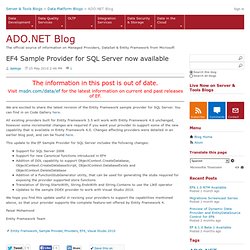
Advance Spatial Queries using Entity Framework 5 - Ricky's Bing Maps Blog. Recently we published a blog post titled “How to Create a Spatial Web Service That Connects a Database to Bing Maps Using EF5.”
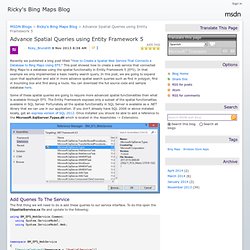
This post showed how to create a web service that connected Bing Maps to a database using the spatial functionality in Entity Framework 5 (EF5). In that example we only implemented a basic nearby search query. In this post, we are going to expand upon that application and add in more advance spatial search queries such as find in polygon, find in bounding box and find along a route. You can download the full source code and sample database here. Some of these spatial queries are going to require more advanced spatial functionalities than what is available through EF5. Add Queries To The Service The first thing we will need to do is add these queries to our service interface. Downloads : Programming Entity Framework. This page will be used to provide code samples from the book and the sample databases.
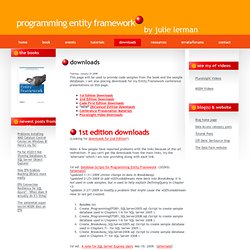
I am also placing downloads for my Entity Framework conference presentations on this page. (Looking for downloads for 2nd Edition?) Note: A few people have reported problems with the links because of the url redirection. If you can't get the downloads from the main links, try the "alternate" which I am now providing along with each link. 1st ed: Database Scripts for Programming Entity Framework (202kb) [alternate] *updated 1/31/2009 (minor change to data in BreakAway) *updated 2/25/2009 to add vOfficeAddresses view back into BreakAway. 1st ed: A note for SQL Server Express Users Mar 10, 2009 [alternate] 1st ed: Chapter 7 BreakAway Model Projects (57kb) Jan 28, 2009 [alternate] *Updated 9/7/2009 with modified ReadMe.TXT Contains VB and CSharp projects for the BreakAway model created in the Chapter 7 walkthroughs. 1st ed: Chapter 18 - Persisted State Entry VB Version.